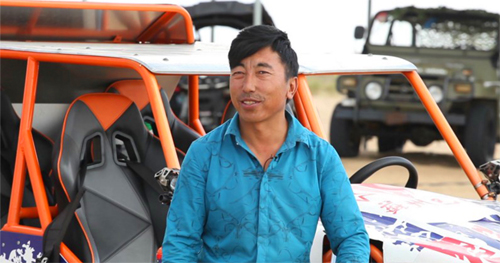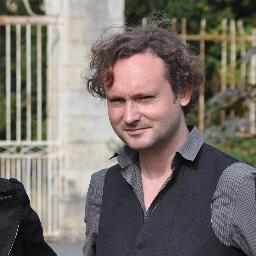The deserts of Mongolia are being turned green by renewable solar energy, bringing new prosperity to the Mongolian people.
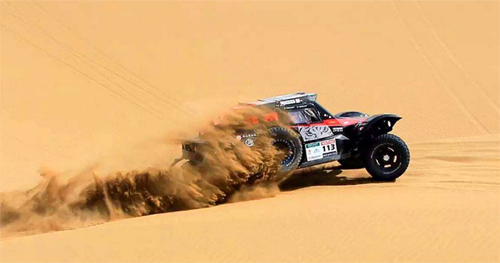
It’s the kind of desert that men die in. A thousand miles of dust, rocks, scrubby weeds and towering sand dunes. Howling wind whips over the wastelands. Followed by the roar of an engine. Rugged tyres tear up fountains of sand, as the powerful All-Terrain Vehicle hurls itself over the dunes.
At the wheel is Tserenbaabuu, Babu or “Baby” to his friends. Babu’s leading a race across the desert, a dozen other ATVs are hot on his heels. But Babu knows this desert, and knows how to drive it, gunning the engine to the perfect pitch to negotiate the next slope. Most of his competition are tourists, seeking adventure in this wild desert. It’s Babu’s job to give it to them, organising these races is his business. Babu is the real Baby Driver.
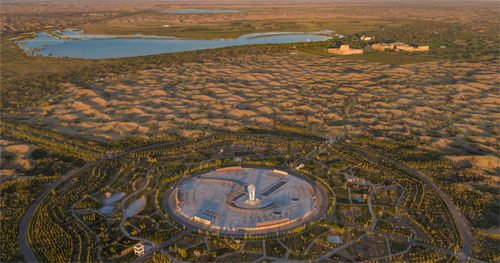
The 4x4s race for the finish line, and out of the desert. Low bushes and lush green trees have turned back the desert. Where once there was only sand, a green oasis has blossomed. A new town, and new houses, have been built in this oasis, a place that Babu and his family are happy to call home.
This is the Kubuqi desert in the Chinese autonomous region of Mongolia. Thirty years ago this was a wasteland of over 18,000 square kilometres, populated by 700,000 people living in absolute poverty. Today over one third of the land has been greened, and the lives of its people transformed.
Yao Liyuan remembers the harsh Kubuqi desert as it once was. She met Babu fifteen years ago, and found him to be a kind and honest man. When Babu’s work in the city was done, Yao gave up her ordinary life and followed her new husband out to the deep desert.
The young Chinese woman found a poverty it is hard to imagine. Even in the early years of the 21st century, the people of the Kubuqi desert still lived in huts of mud and straw, ate what little food they had from a large stone that served as a table, and lived without even the simplest comforts.
Babu’s parents lived their entire lives in the desert. They knew nothing of the modern world of cities, aeroplanes and computers. Only the stories they heard at the village market, where Babu’s father sold wool, and the licorice roots the family foraged, to pay for essential supplies. The market was three full days journey from home. A doctor might journey a week to reach them.
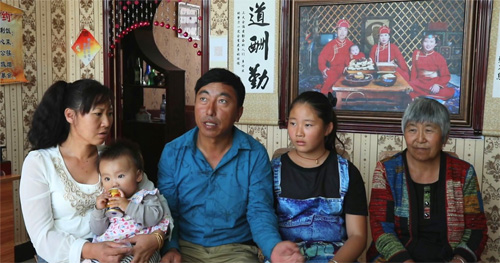
As a boy, Tserenbaabuu dreamed what seemed an impossible dream. He was a boy dressed in patchwork rags, that would be adjusted and handed down to his sisters. Many nights he would go to sleep, looking up at the bright stars, his belly growling with hunger. And dream of driving the ATVs that sometimes came roaring through the village market.
In 2006 Babu’s dream came true. An investment of 20 million yuan made into the region changed everything. A new town and new houses were built, with water and power and new wide roads. Along with this new development came support for local tribes people to start new businesses. Restaurants and guest houses opened to support a booming tourist trade. Babu made his dream a reality, when he began a business to race ATVs over the desert.
When Babu and Yao had a daughter, they named her Yun Mengsha, containing the strokes for “grass”, and meaning in Chinese, verdancy, vigour and hope. The investment that raised Babu and Yao and their family out of poverty, and that began the greening of Kubuqi valley, was driven by a new industry bringing hope to the world: solar power.
“Beneath the solar panels, licorice is grown. The traditional crop of the Kubuqi tribespeople is still at the heart of their community.”
There is one resource that the Kubuqi desert possesses in unlimited quantities.
Sunlight.
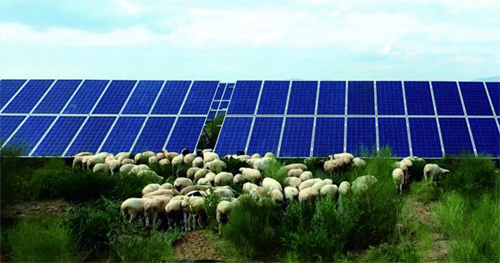
As the developed world, in particular the United States under the leadership of Donald Trump, and the influence of oil industry lobbyists, shuns renewable energy, the developing world sees its opportunity to take the lead. Vast solar energy farms now cover miles of the Kubuqi desert, turning the boiling sun that once killed men, into a vital resource that sustains life.
Beneath the solar panels, licorice is grown. The traditional crop of the Kubuqi tribespeople is still at the heart of their community, selling for a small fortune to the Chinese medicinal market. It’s this fusion of sustainable energy, and traditional wisdom, that marks out the development and growth lead by Elion Resources Group.
Elion’s work in the Kubuqi desert reaches back 30 years. Over that time it has invested 3 billion RMB in restoration of the desert ecosystem, and 38 billion RMB in desert industries, with solar energy as their central focus. This investment has created from nothing a new regional economy now worth hundreds of billions every year, and has covered 6000 square km with new life.
The greening of the Kubqui desert is a visible symbol of the economic and social transformation being made here. As new roots have grown to capture the desert, the sand storms that sweep out from Mongolia and over Beijing will begin to lessen, just as reducing the poverty of the desert tribespeople will raise up all of China.
